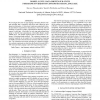Free Online Productivity Tools
i2Speak
i2Symbol
i2OCR
iTex2Img
iWeb2Print
iWeb2Shot
i2Type
iPdf2Split
iPdf2Merge
i2Bopomofo
i2Arabic
i2Style
i2Image
i2PDF
iLatex2Rtf
Sci2ools
ICASSP
2010
IEEE
2010
IEEE
Model-level data-driven sub-units for signs in videos of continuous Sign Language
We investigate the issue of sign language automatic phonetic subunit modeling, that is completely data driven and without any prior phonetic information. A first step of visual processing leads to simple and effective region-based visual features. Prior to the sub-unit modeling we propose to employ a pronunciation clustering step with respect to each sign. Afterwards, for each sign and pronunciation group we find the time segmentation at the hidden Markov model (HMM) level. The models employed refer to movements as a sequence of dominant hand positions. The constructed segments are exploited explicitly at the model level via hierarchical clustering of HMMs and lead to the data-driven movement sub-unit construction. The constructed movement sub-units are evaluated in qualitative analysis experiments on data from the Boston University (BU)400 American Sign Language corpus showing promising results.
Automatic Phonetic Subunit | ICASSP 2010 | Prior Phonetic Information | Region-based Visual Features | Signal Processing |
| Added | 06 Dec 2010 |
| Updated | 06 Dec 2010 |
| Type | Conference |
| Year | 2010 |
| Where | ICASSP |
| Authors | Stavros Theodorakis, Vassilis Pitsikalis, Petros Maragos |
Comments (0)

